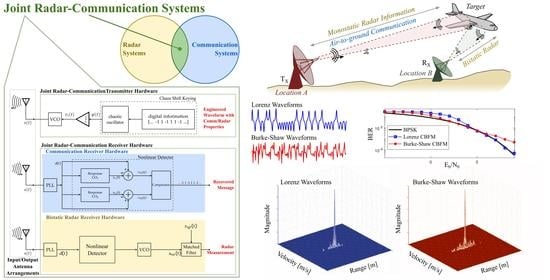Chaos Based Frequency Modulation for Joint Monostatic and Bistatic Radar-Communication Systems
Abstract
:1. Introduction
2. Contributions of Our Work
- Generate a chaos-based frequency-modulated (CBFM) waveform for dual functionality. First, the chaos shift-keying approach is used to encode digital information onto the chaotic system and thereby using it as an instantaneous frequency to transmit CBFM pulses.
- Show that the proposed waveforms perform better in terms of bit-error rate and imaging capabilities than the current RadComm waveforms.
- Demonstrate that the CBFM waveform in bistatic configuration solves two issues. Firstly, reconstruct the transmitted waveform at the receiver via a direct synchronization scheme and a simple response chaotic oscillator. Secondly, to obtain the high-resolution imagery of targets.
- Illustrate the high-resolution imaging capabilities of the CBFM waveform for a monostatic radar mode.
3. Generation of CBFM Waveforms for Joint Radar-Communications
4. Communication Receiver
5. Bistatic Radar Receiver Synchronization and Ambiguity Function
5.1. Synchronizing the Bistatic Radar Receiver
5.2. Cross-Ambiguity Functions
5.3. Signature Analysis for the Bistatic Radar Configuration
5.4. Cross-Ambiguity Functions in the Presence of Noise
6. Monostatic Radar Signal Processing
6.1. Ambiguity Surface of Monostatic CBFM Radar
6.2. Signature Analysis for the Monostatic Radar Configuration
6.3. Ambiguity Functions in the Presence of Noise
7. Conclusions
Author Contributions
Funding
Institutional Review Board Statement
Informed Consent Statement
Data Availability Statement
Conflicts of Interest
References
- Tavik, G.C.; Hilterbrick, C.L.; Evins, J.B.; Alter, J.J.; Crnkovich, J.G.; de Graaf, J.W.; Habicht, W., II; Hrin, G.P.; Lessin, S.A.; Wu, D.C.; et al. The advanced multifunction RF concept. IEEE Trans. Microw. Theory Tech. 2005, 53, 1009–1020. [Google Scholar] [CrossRef]
- Griffiths, H.; Cohen, L.; Watts, S.; Mokole, E.; Baker, C.; Wicks, M.; Blunt, S. Radar spectrum engineering and management: Technical and regulatory issue. Proc. IEEE 2015, 103, 85–102. [Google Scholar] [CrossRef]
- Zheng, L.; Lops, M.; Eldar, Y.C.; Wang, X. Radar and Communication Coexistence: An Overview: A Review of Recent Methods. IEEE Signal Process. Mag. 2019, 36, 85–99. [Google Scholar] [CrossRef]
- Cohen, D.; Mishra, K.V.; Eldar, Y.C. Spectrum sharing radar: Coexistence via Xampling. IEEE Trans. Aerosp. Electron. Syst. 2017, 54, 1279–1296. [Google Scholar] [CrossRef]
- Li, B.; Petropulu, A.P.; Trappe, W. Optimum co-design for spectrum sharing between matrix completion based MIMO radars and a MIMO communication system. IEEE Trans. Signal Process. 2016, 64, 4562–4575. [Google Scholar] [CrossRef] [Green Version]
- Qian, J.; Lops, M.; Zheng, L.; Wang, X.; He, Z. Joint system design for coexistence of MIMO radar and MIMO communication. IEEE Trans. Signal Process. 2018, 66, 3504–3519. [Google Scholar] [CrossRef]
- Li, B.; Petropulu, A.P. Joint transmit designs for coexistence of MIMO wireless communications and sparse sensing radars in clutter. IEEE Trans. Aerosp. Electron. Syst. 2017, 53, 2846–2864. [Google Scholar] [CrossRef]
- Liu, F.; Christos, M.; Petropulu, A.; Griffiths, H.; Hanzo, L. Joint radar and communication design: Applications, state-of-the-art, and the road ahead. IEEE Trans. Commun. 2020, 68, 3834–3862. [Google Scholar] [CrossRef] [Green Version]
- Deng, H.; Himed, B. Interference Mitigation Processing for Spectrum-Sharing Between Radar and Wireless Communications Systems. IEEE Trans. Aerosp. Electron. Syst. 2013, 49, 1911–1919. [Google Scholar] [CrossRef]
- Kumar, S.; Mishra, K.V.; Gautam, S.; Mysore, B.S.; Ottersten, B. Interference Mitigation Methods for Coexistence of Radar and Communication. In Proceedings of the 15th European Conference on Antennas and Propagation (EuCAP), Dusseldorf, Germany, 22–26 March 2021; pp. 1–4. [Google Scholar]
- Han, L.; Wu, K. Joint wireless communication and radar sensing systems-state of the art and future prospects. IET Microwaves, Antennas Propag. 2013, 7, 876–885. [Google Scholar] [CrossRef]
- Blunt, S.D.; Yatham, P.; Stiles, J. Intrapulse Radar-Embedded Communications. IEEE Trans. Aerosp. Electron. Syst. 2010, 46, 1185–1200. [Google Scholar] [CrossRef]
- Huang, K.W.; Bica, M.; Mitra, U.; Koivunen, V. Radar waveform design in spectrum sharing environment: Coexistence and cognition. In Proceedings of the IEEE Radar Conference (RadarCon), Arlington, VA, USA, 10–15 May 2015; pp. 1698–1703. [Google Scholar]
- Zhang, Z.; Nowak, M.J.; Wicks, M.C.; Wu, Z. Bio-inspired RF steganography via linear chirp radar signals. IEEE Commun. Mag. 2016, 54, 82–86. [Google Scholar] [CrossRef]
- Zhang, Z.; Qu, Y.; Wu, Z.; Nowak, M.J.; Ellinger, J.; Wicks, M.C. RF steganography via LFM chirp radar signals. IEEE Trans. Aerosp. Electron. Syst. 2017, 54, 1221–1236. [Google Scholar] [CrossRef]
- Hassanien, A.; Amin, M.G.; Zhang, Y.D.; Ahmad, F. Phase-modulation based dual-function radar-communications. IET Radar Sonar Navig. 2016, 10, 1411–1421. [Google Scholar] [CrossRef] [Green Version]
- Washington, R.; Bischof, B.; Garmatyuk, D.; Mudaliar, S. Clutter-Masked Waveform Design for LPI/LPD Radarcom Signal Encoding. Sensors 2021, 21, 631. [Google Scholar] [CrossRef]
- Bekar, M.; Baker, C.J.; Hoare, H.G.; Gashinova, M. Joint MIMO Radar and Communication System Using a PSK-LFM Waveform With TDM and CDM Approaches. IEEE Sens. J. 2021, 21, 6115–6124. [Google Scholar] [CrossRef]
- Hassanien, A.; Amin, M.G.; Aboutanios, E.; Himed, B. Dual-Function Radar Communication Systems: A Solution to the Spectrum Congestion Problem. IEEE Signal Process. Mag. 2019, 36, 115–126. [Google Scholar] [CrossRef]
- Wehner, D.R. High-Range Resolution Waveforms and Processing. In High-Resolution Radar, 2nd ed.; Artech House: Boston, MA, USA, 1994; pp. 133–194. [Google Scholar]
- Lathi, B.P.; Ding, Z. Performance analysis of digital communication systems. In Modern Digital and Analog Communication Systems, 4th ed.; Oxford University Press: New York, NY, USA, 2009; pp. 506–581. [Google Scholar]
- Surender, S.C.; Narayanan, R.M. UWB noise-OFDM netted radar: Physical layer design and analysis. IEEE Trans. Aerosp. Electron. Syst. 2011, 47, 1380–1400. [Google Scholar] [CrossRef]
- Kocarev, L.; Halle, K.S.; Eckert, K.; Chua, L.O.; Parlitz, U. Experimental Demonstration of Secure Communications via Chaotic Synchronization. Int. J. Bifurcations Chaos Appl. Sci. Technol. 1992, 2, 709–713. [Google Scholar] [CrossRef]
- Cuomo, K.M.; Oppenheim, A.V. Circuit Implementation of Synchronized Chaos with Applications to Communications. Phys. Rev. Lett. 1993, 71, 65–68. [Google Scholar] [CrossRef]
- Dedieu, H.; Kennedy, M.P.; Hasler, M. Chaos shift keying: Modulation and demodulation of a chaotic carrier using self-synchronizing Chua’s circuits. IEEE Trans. Circuits Syst. II Analog. Digit. Signal Process. 1993, 40, 634–642. [Google Scholar] [CrossRef]
- Kolumban, G.; Kennedy, M.P.; Chua, L.O. The Role of Synchronization in Digital Communications Using Chaos-Part I: Fundamentals of Digital Communications. IEEE Trans. Circuits Syst.-Part I Fundam. Theory Appl. 1997, 44, 927–935. [Google Scholar] [CrossRef] [Green Version]
- Mazzini, G.; Setti, G.; Rovatti, R. Chaotic complex spreading sequences for asynchronous DS-CDMA. I. System modeling and results. IEEE Trans. Circuits-Syst.-Part I Fundam. Theory Appl. 1997, 44, 937–947. [Google Scholar] [CrossRef]
- Rulkov, N.F.; Tsimring, L. Communication with Chaos over Band-Limited Channels. Int. J. Circuit Theory Appl. 1999, 27, 555–567. [Google Scholar] [CrossRef]
- Abel, A.; Schwartz, W.; Goetz, M. Noise Performance of Chaotic Communication Systems. IEEE Trans. Circuits-Syst.-Part I Fundam. Theory Appl. 2000, 47, 1726–1732. [Google Scholar] [CrossRef]
- Williams, C. Chaotic Communications over Radio Channels. IEEE Trans. Circuits Syst.-Part I Fundam. Theory Appl. 2001, 48, 1394–1404. [Google Scholar] [CrossRef]
- Abel, A.; Schwarz, W. Chaos communications-principles, schemes, and system analysis. Proc. IEEE 2002, 90, 691–710. [Google Scholar] [CrossRef]
- Argyris, A.; Syvridis, D.; Larger, L.; Annovazzi-Lodi, V.; Colet, P.; Fischer, I.; Garcia-Ojalvo, J.; Mirasso, C.R.; Pesquera, L.; Shore, K.A. Chaos-based communications at high bit rates using commercial fibre-optic links. Nature 2005, 438, 343–346. [Google Scholar] [CrossRef] [PubMed]
- Blakely, J.N.; Hahs, D.W.; Corron, N.J. Communication waveform properties of an exact folded-band chaotic oscillator. Phys. D Nonlinear Phenom. 2013, 263, 99–106. [Google Scholar] [CrossRef]
- Kaddoum, G.; Soujeri, E. NR-DCSK: A Noise Reduction Differential Chaos Shift Keying System. IEEE Trans. Circuits Syst. II Express Briefs 2016, 63, 648–652. [Google Scholar] [CrossRef] [Green Version]
- Myneni, K.; Barr, T.A.; Reed, B.R.; Pethel, S.D.; Corron, N.J. High-precision ranging using a chaotic laser pulse train. Appl. Phys. Lett. 2001, 78, 1496–1498. [Google Scholar] [CrossRef]
- Beal, A.N.; Cohen, S.D.; Syed, T.M. Generating and detecting solvable chaos at radio frequencies with consideration to multi-user ranging. Sensors 2020, 20, 774. [Google Scholar] [CrossRef] [PubMed] [Green Version]
- Flores, B.C.; Solis, E.A.; Thomas, G. Assessment of chaos-based FM signals for range–Doppler imaging. IEE Proc.-Radar Sonar Navig. 2003, 150, 313–322. [Google Scholar] [CrossRef]
- Lin, F.; Liu, J. Ambiguity functions of laser-based chaotic radar. IEEE J. Quantum Electron. 2004, 40, 1732–1738. [Google Scholar] [CrossRef]
- Liu, Z.; Zhu, X.; Hu, W.; Jiang, F. Principles of chaotic signal radar. Int. J. Bifurc. Chaos 2007, 17, 1735–1739. [Google Scholar] [CrossRef]
- Shi, Z.; Qiao, S.; Chen, K.S.; Cui, W.; Ma, W.; Jiang, T.; Ran, L. Ambiguity functions of direct chaotic radar employing microwave chaotic Colpitts oscillator. Prog. Electromagn. Res. 2007, 77, 1–14. [Google Scholar] [CrossRef] [Green Version]
- Willsey, M.S.; Cuomo, K.M.; Oppenheim, A.V. Quasi-orthogonal wideband radar waveforms based on chaotic systems. IEEE Trans. Aerosp. Electron. Syst. 2011, 47, 1974–1984. [Google Scholar] [CrossRef] [Green Version]
- Sprott, J.C. Introduction. In Chaos and Time-Series Analysis; Oxford University Press: New York, NY, USA, 2003; pp. 1–19. [Google Scholar]
- Sprott, J.C. Strange Attractors. In Chaos and Time-Series Analysis; Oxford University Press: New York, NY, USA, 2003; pp. 127–158. [Google Scholar]
- Lorenz, E.N. Synchronisation of bistatic radar systems. J. Atmos. Sci. 1963, 20, 130–141. [Google Scholar] [CrossRef] [Green Version]
- Shaw, R. Strange attractors, chaotic behavior, and information flow. Z. Für Naturforschung 1981, 36, 80–112. [Google Scholar] [CrossRef]
- Chua, L.O.; Wu, C.W.; Huang, A.; Zhong, G.Q. A universal circuit for studying and generating chaos—Part. I: Routes to chaos. IEEE Trans. Circuits Syst. I Fundam. Theory Appl. 1993, 40, 732–744. [Google Scholar] [CrossRef]
- Carroll, T.L. Chaotic communications that are difficult to detect. Phys. Rev. E 2003, 67, 026207-1–026207-6. [Google Scholar] [CrossRef]
- Tlelo-Cuautle, E.; Mu noz-Pacheco, J.M.; Martínez-Carballido, J. Frequency scaling simulation of Chua’s circuit by automatic determination and control of step-size. Appl. Math. Comput. 2007, 194, 486–491. [Google Scholar] [CrossRef]
- Cuenot, J.B.; Larger, L.; Goedgebuer, J.P.; Rhodes, W.T. Chaos shift keying with an optoelectronic encryption system using chaos in wavelength. IEEE J. Quantum Electron. 2001, 37, 849–855. [Google Scholar] [CrossRef]
- Geist, K.; Parlitz, U.; Lauterborn, W. Comparison of different methods for computing Lyapunov exponents. Prog. Theor. Phys. 1990, 83, 875–893. [Google Scholar] [CrossRef]
- Li, C.; Sprott, J.C. Amplitude control approach for chaotic signals. Nonlinear Dyn. 2013, 73, 1335–1341. [Google Scholar] [CrossRef] [Green Version]
- Pecora, L.M.; Carroll, T.L. Synchronization in Chaotic Systems. Phys. Rev. Lett. 1990, 64, 821–824. [Google Scholar] [CrossRef]
- Pecora, L.M.; Carroll, T.L. Synchronization of chaotic systems. Chaos Interdiscip. J. Nonlinear Sci. 2015, 25, 097611. [Google Scholar] [CrossRef] [PubMed]
- Ziemer, R.E.; Tranter, W.H. Angle Modulation and Multiplexing. In Principles of Communication Systems, Modulation and Noise, 7th ed.; John Wiley & Sons: Hoboken, NJ, USA, 2014; pp. 156–213. [Google Scholar]
- Weib, M. Synchronisation of bistatic radar systems. IEEE Int. Geosci. Remote Sens. Symp. (IGARSS) 2004, 3, 1750–1753. [Google Scholar]
- Sandenbergh, J.S. Synchronising Coherent Networked Radar using Low-Cost GPS-Disciplined Oscillators. Ph.D. Thesis, University of Cape Town, Cape Town, South Africa, 2019. [Google Scholar]
- Carroll, T.L. Chaotic system for self-synchronizing Doppler measurement. Chaos Interdiscip. J. Nonlinear Sci. 2005, 15, 013109-1–013109-5. [Google Scholar] [CrossRef] [PubMed]
- Sorrentino, F.; DeLellis, P. Estimation of communication-delays through adaptive synchronization of chaos. Chaos Solitons Fractals 2012, 45, 35–46. [Google Scholar] [CrossRef] [Green Version]
- Pappu, C.S.; Flores, B.C. High Resolution Imaging of Chaotic Bistatic Radar. IEEE Trans. Aerosp. Electron. Syst. 2011, 56, 871–886. [Google Scholar] [CrossRef]
- Willis, N.J. Special Problems and Requirements. In Bistatic Radar; Scitech Publishing Inc.: Raleigh, NC, USA, 2005; pp. 245–260. [Google Scholar]
- Tsao, T.; Slamani, M.; Varshney, P.; Weiner, D.; Schwarzlander, H.; Borek, S. Ambiguity function for a bistatic radar. IEEE Trans. Aerosp. Electron. Syst. 1997, 33, 1041–1051. [Google Scholar] [CrossRef]
- Trees, H.L. Parameter estimation: Slowly-Fluctuating point targets. In Detection, Estimation, and Modulation Theory, Part III: Radar-Sonar Signal Processing and Gaussian Signals in Noise; Wiley: New York, NY, USA, 2001; pp. 275–340. [Google Scholar]
- Borkar, V.G.; Ghosh, A.; Singh, R.K.; Chourasia, N.K. Radar cross-section measurement techniques. Def. Sci. J. 2010, 60, 204. [Google Scholar] [CrossRef]
- Chen, V.C.; Qian, S. Joint time-frequency transform for radar range-Doppler imaging. IEEE Trans. Aerosp. Electron. Syst. 1998, 34, 486–499. [Google Scholar] [CrossRef]
- Son, J.S.; Thomas, G.; Flores, B.C. ISAR Concepts. In Range-Doppler Radar Imaging and Motion Compensation; Artech House: Boston, MA, USA, 2001; pp. 9–25. [Google Scholar]
- Flores, B.C.; Ugarte, A.; Kreinovich, V. Choice of an entropy-like function for range-Doppler processing. Autom. Object Recognit. III Int. Soc. Opt. Photonics (SPIE) 1993, 1960, 47–56. [Google Scholar]
- Abramovich, Y.I.; Frazer, G.J. Bounds on the volume and height distributions for the mimo radar ambiguity function. IEEE Signal Process. Lett. 2008, 15, 505–508. [Google Scholar] [CrossRef]

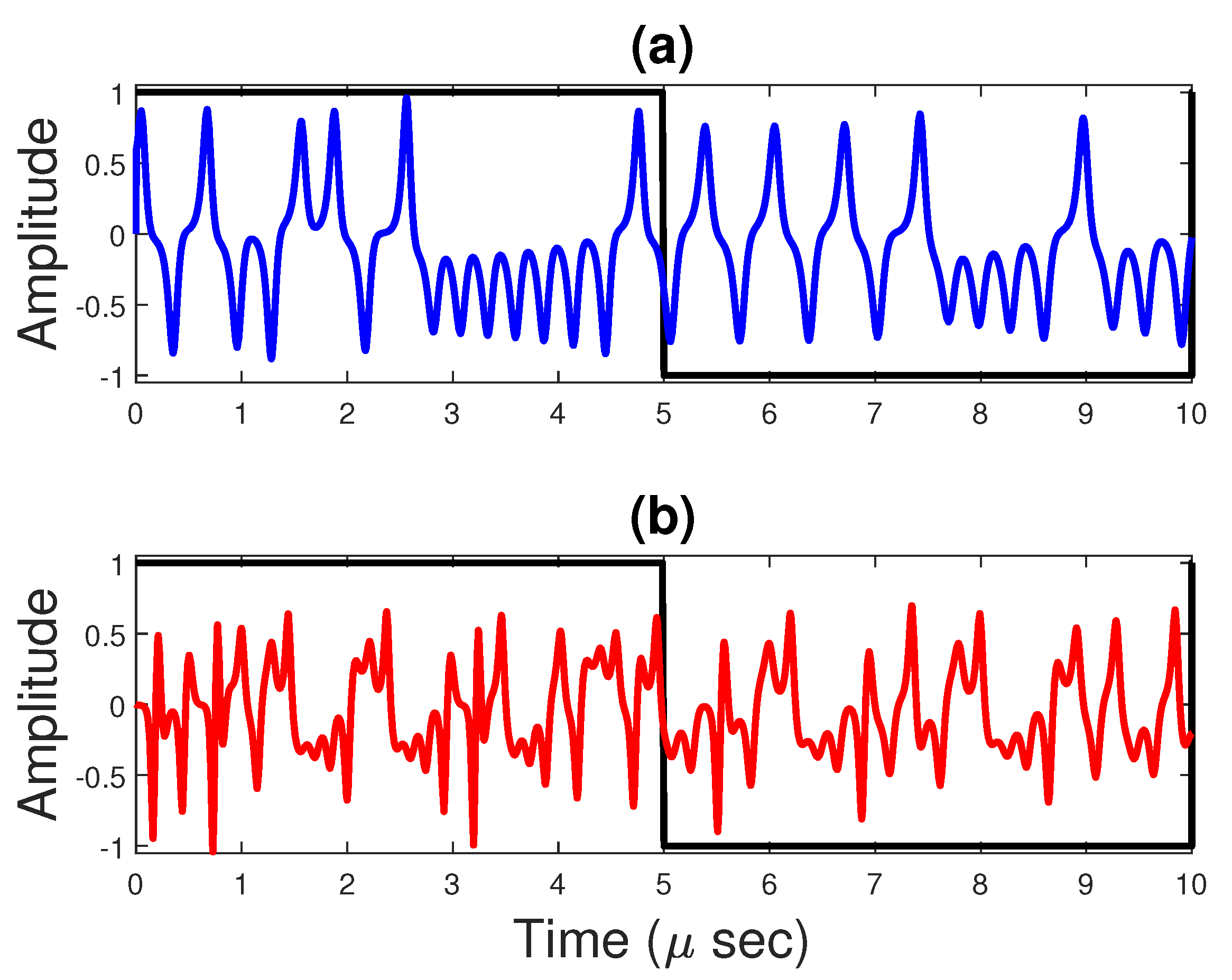


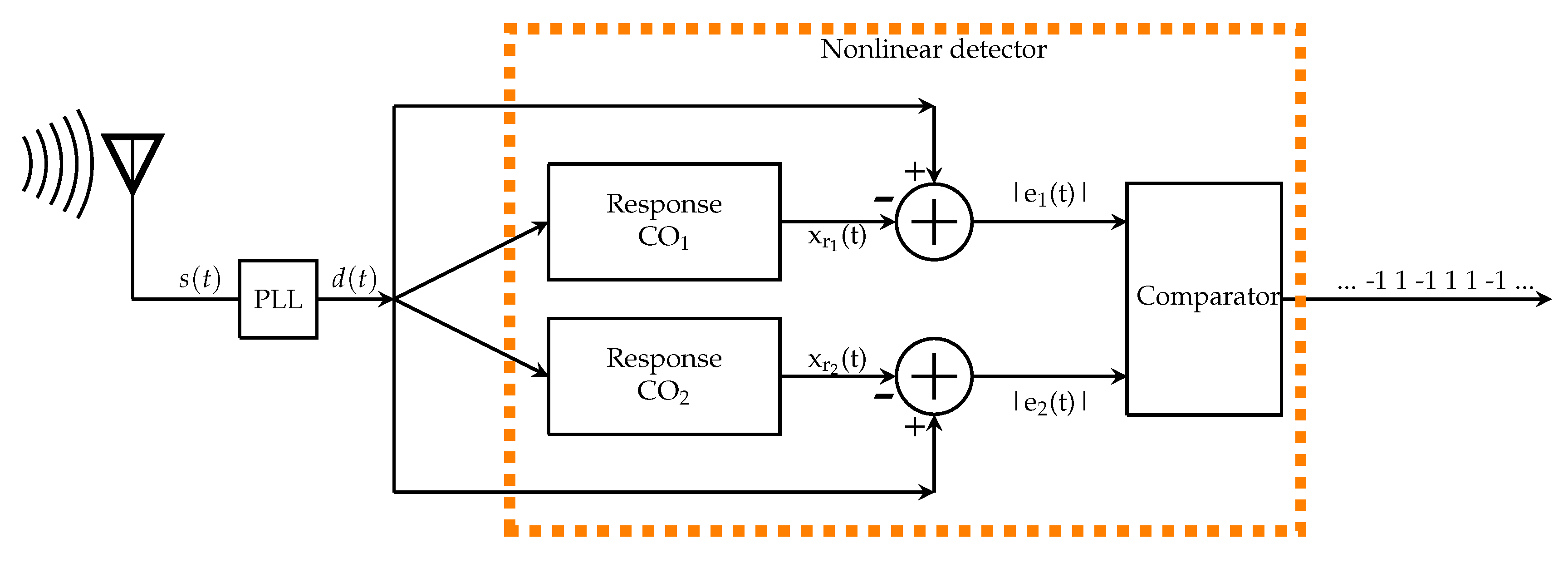


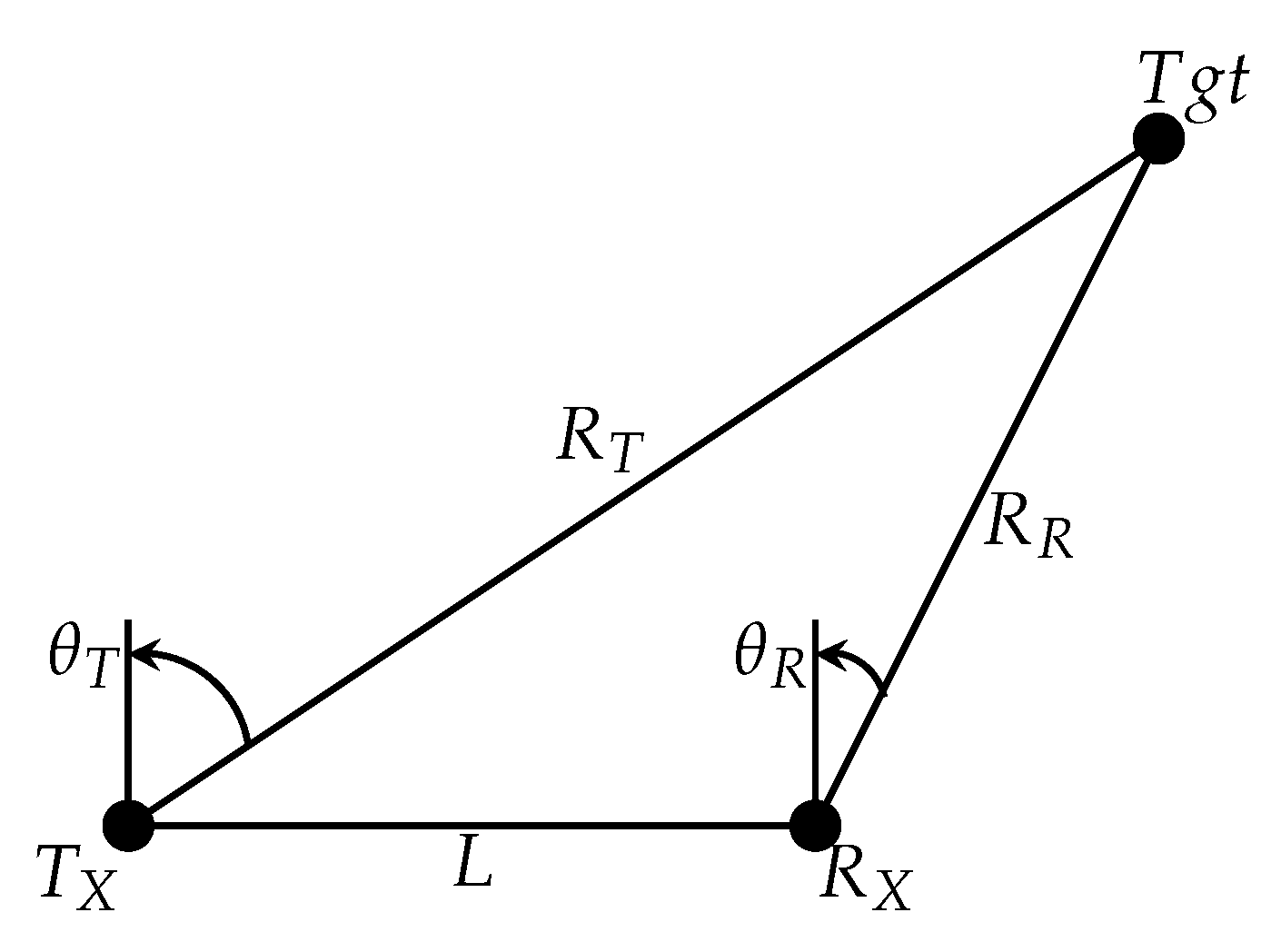

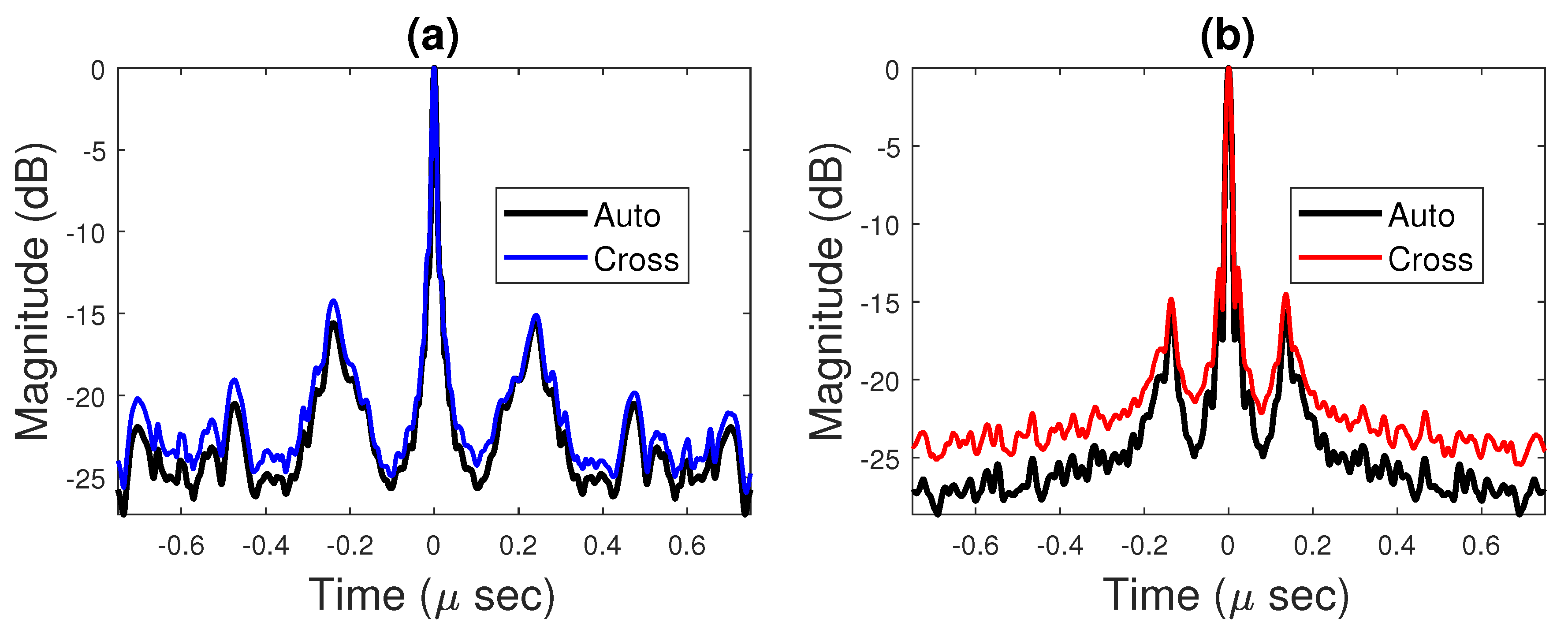
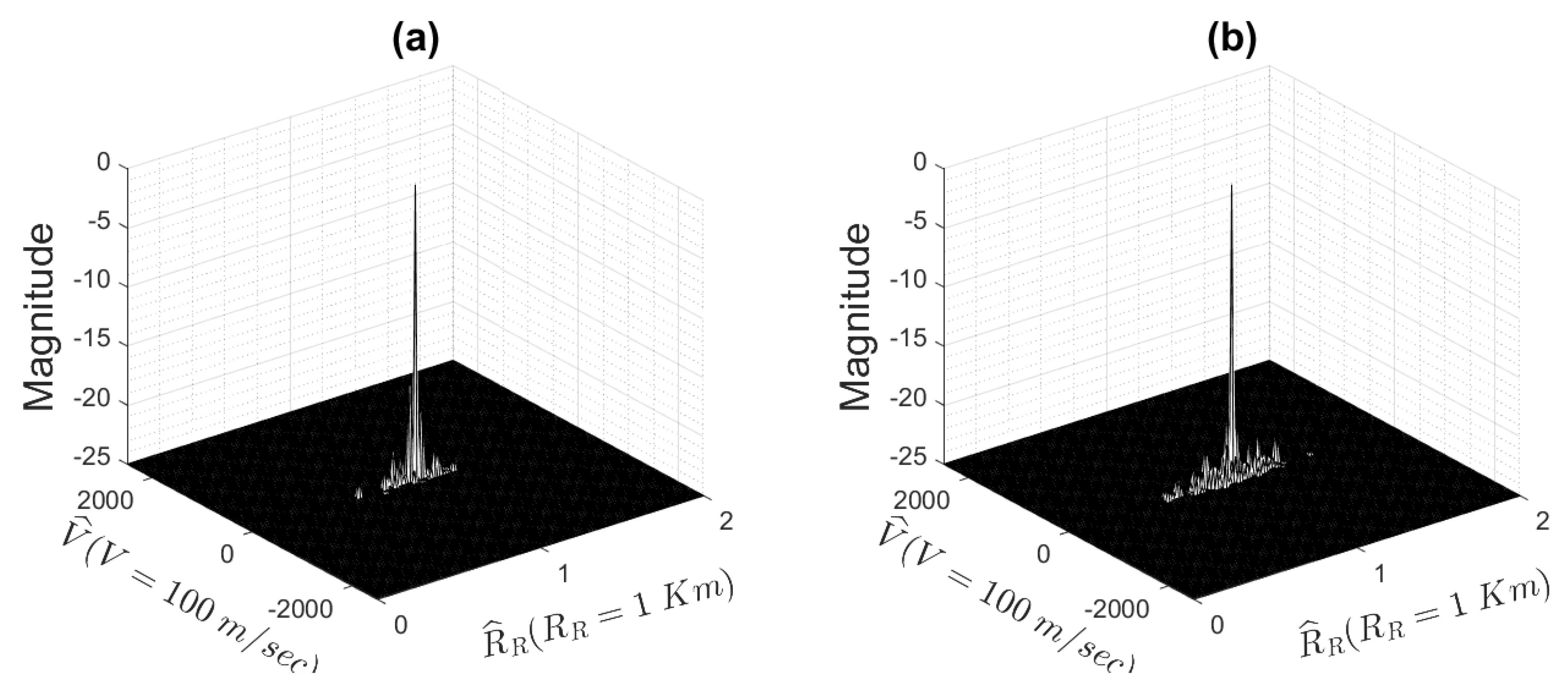

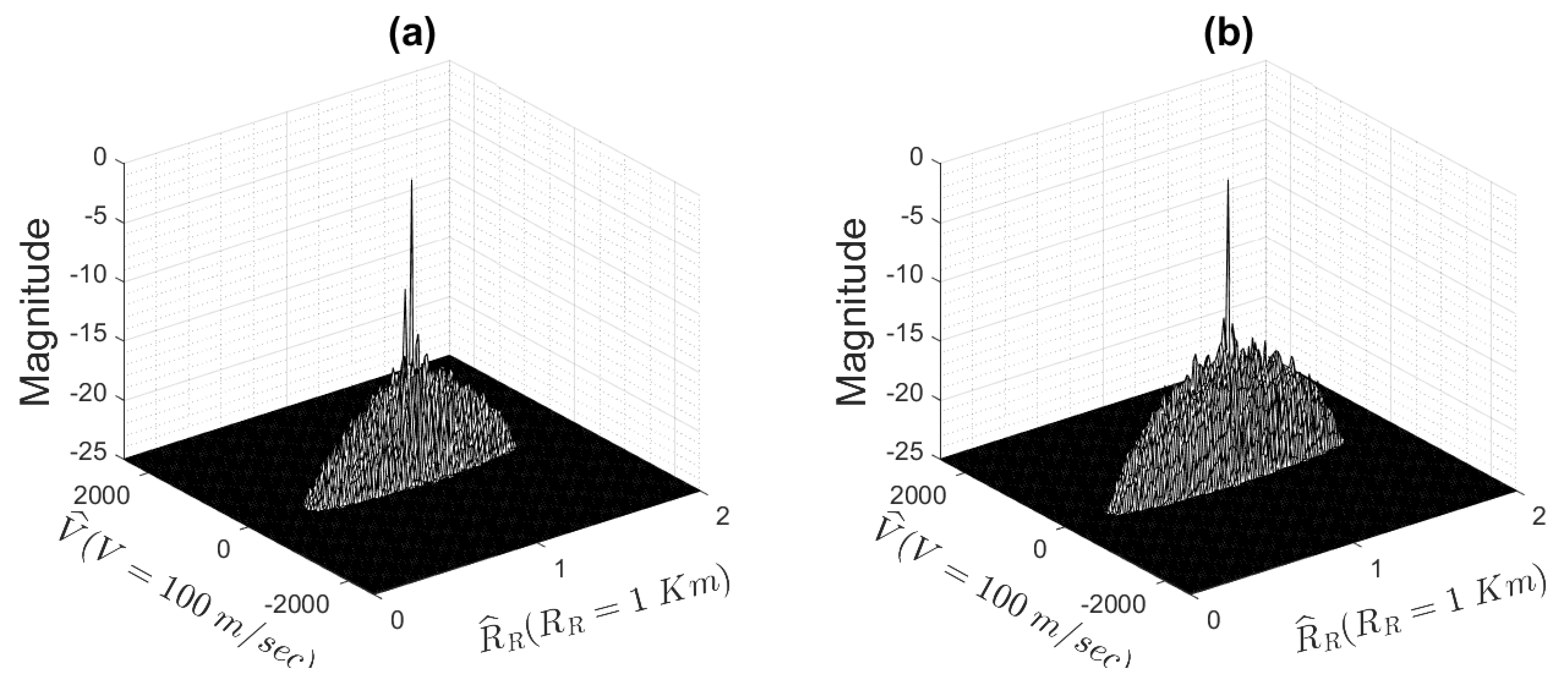
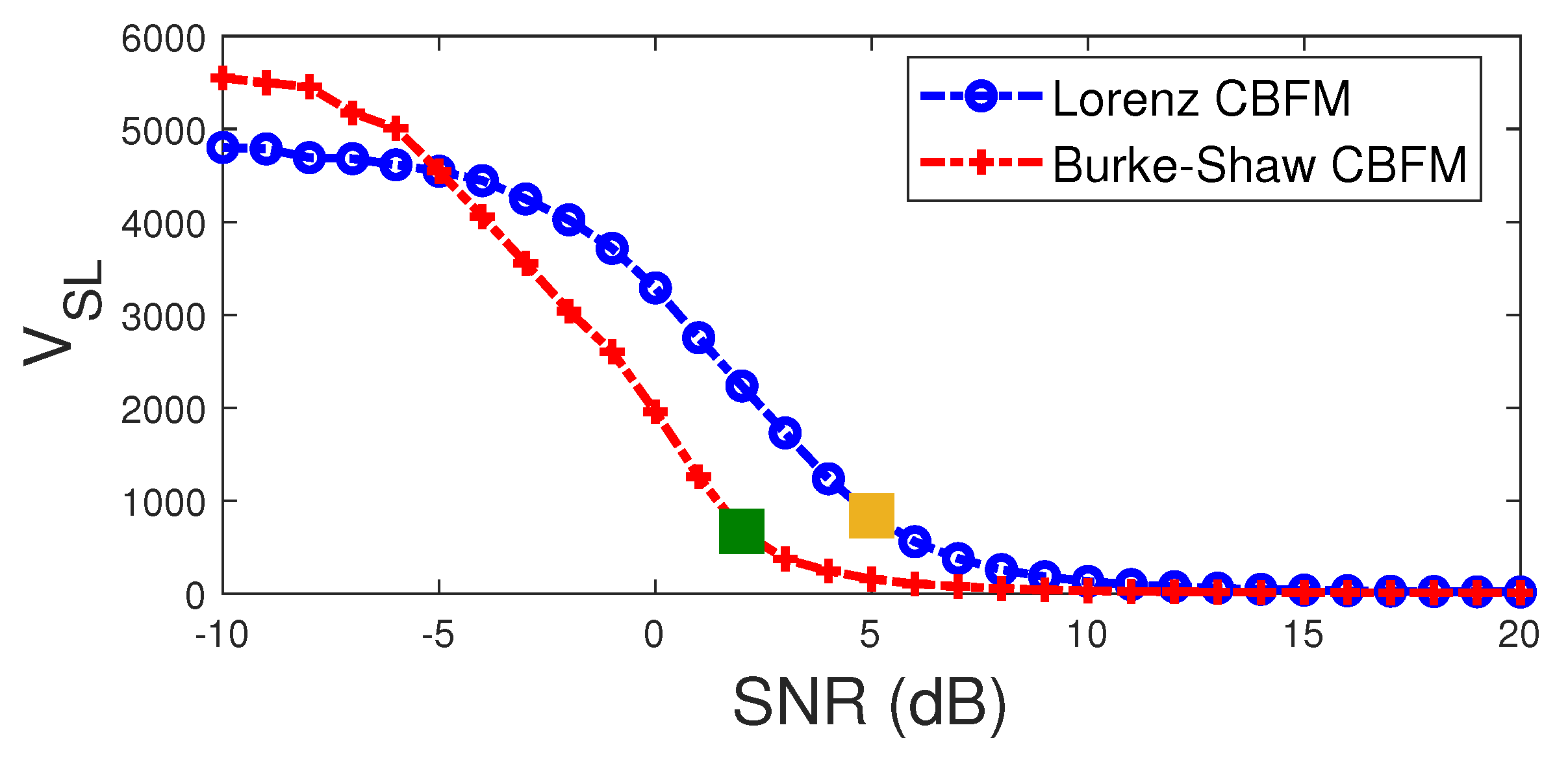

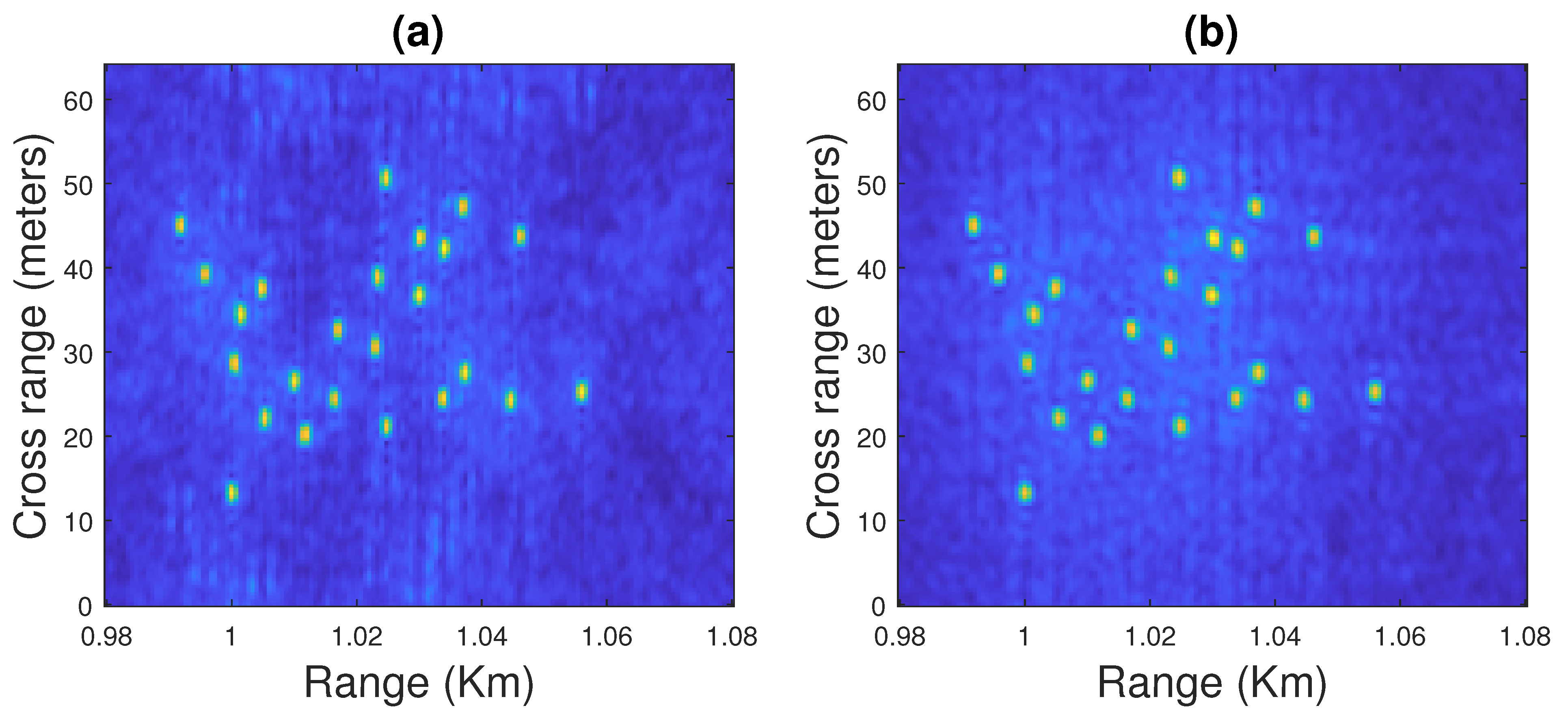
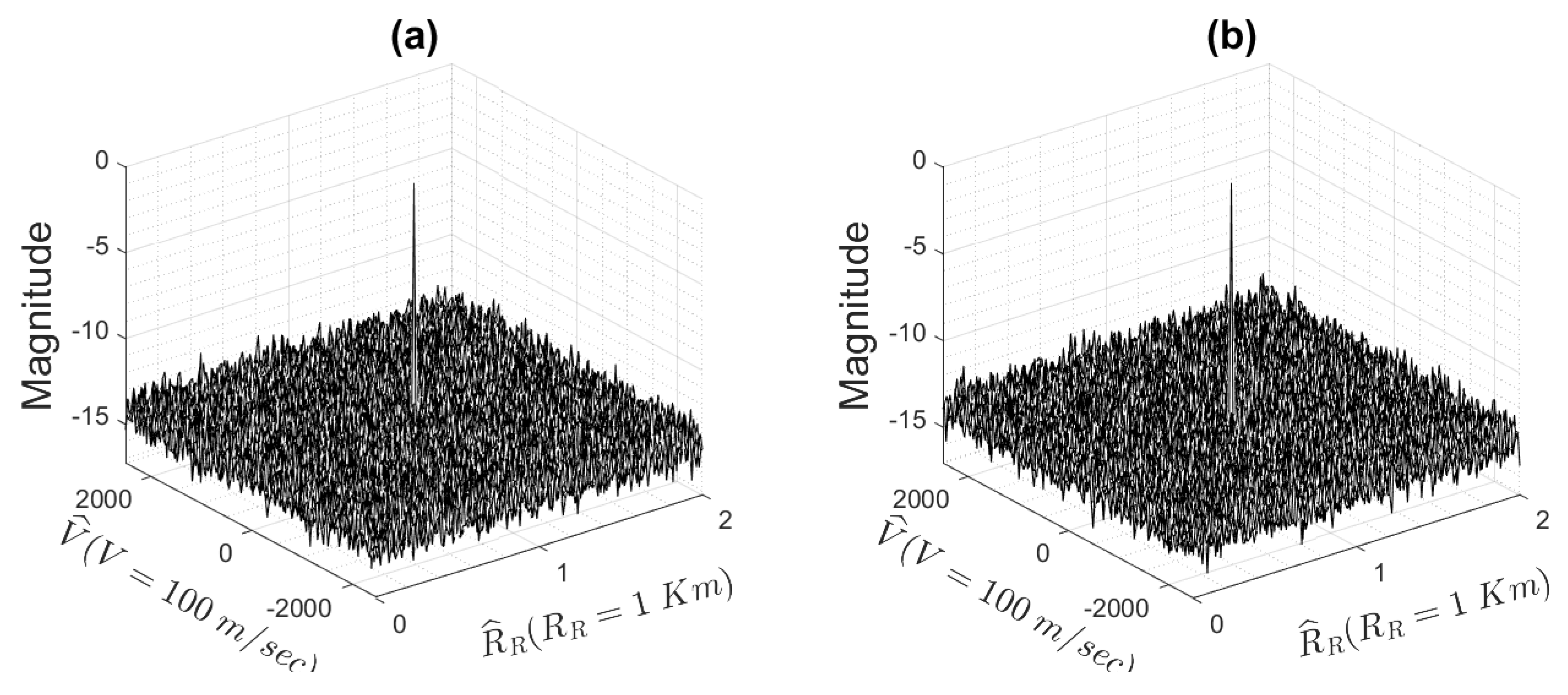
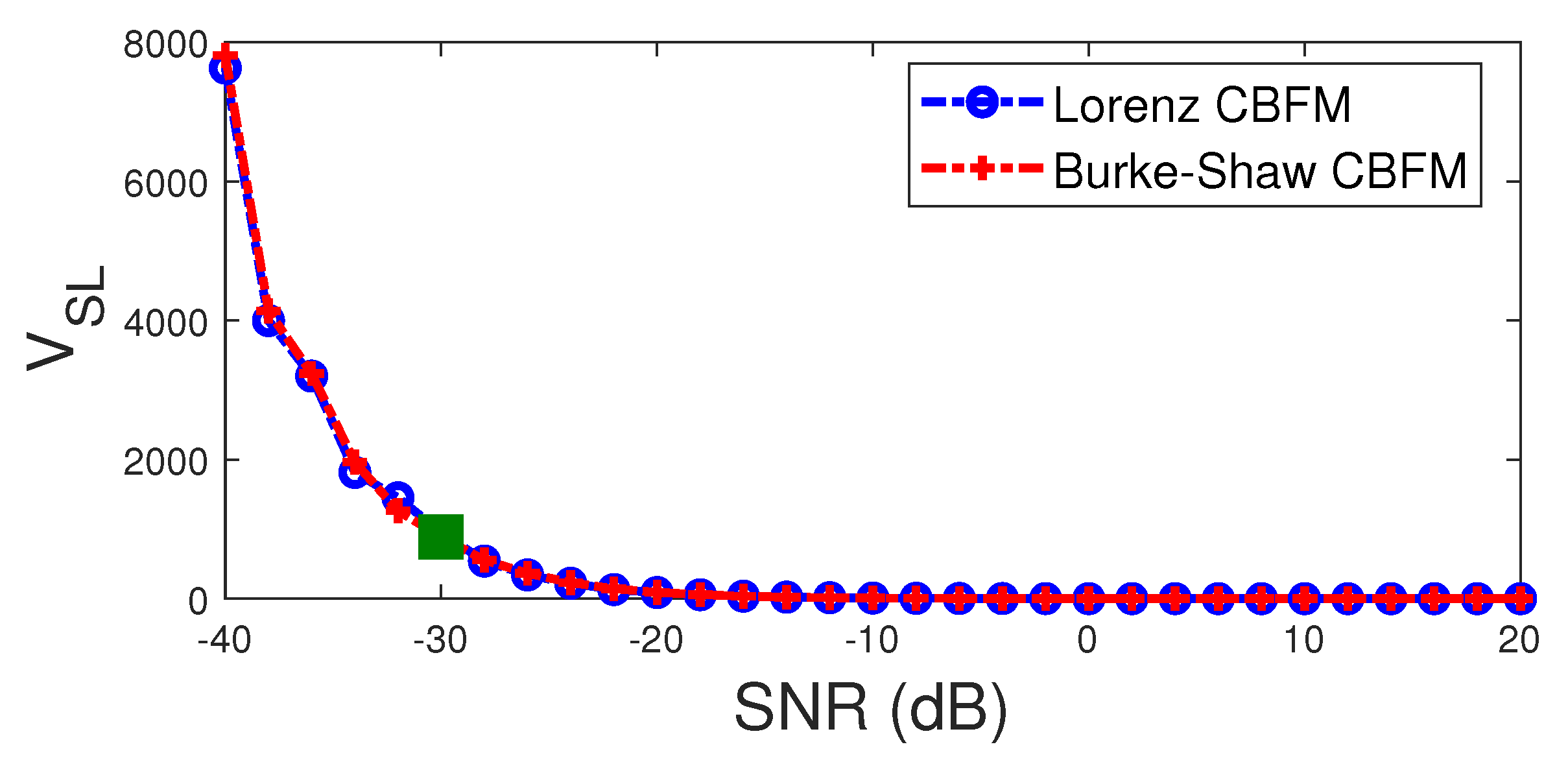
| System | Differential Equations at the Transmitter | Control Parameters | Largest Lyapunov Exponents |
|---|---|---|---|
| Lorenz | , , | ||
| Burke–Shaw | ,, , |
| System | Differential Equations of RCOs | Conditional Lyapunov Exponents | |
|---|---|---|---|
| Lorenz | RCO1 | ||
| RCO2 | |||
| Burke–Shaw | RCO1 | ||
| RCO2 | |||
Publisher’s Note: MDPI stays neutral with regard to jurisdictional claims in published maps and institutional affiliations. |
© 2021 by the authors. Licensee MDPI, Basel, Switzerland. This article is an open access article distributed under the terms and conditions of the Creative Commons Attribution (CC BY) license (https://creativecommons.org/licenses/by/4.0/).
Share and Cite
Pappu, C.S.; Beal, A.N.; Flores, B.C. Chaos Based Frequency Modulation for Joint Monostatic and Bistatic Radar-Communication Systems. Remote Sens. 2021, 13, 4113. https://doi.org/10.3390/rs13204113
Pappu CS, Beal AN, Flores BC. Chaos Based Frequency Modulation for Joint Monostatic and Bistatic Radar-Communication Systems. Remote Sensing. 2021; 13(20):4113. https://doi.org/10.3390/rs13204113
Chicago/Turabian StylePappu, Chandra S., Aubrey N. Beal, and Benjamin C. Flores. 2021. "Chaos Based Frequency Modulation for Joint Monostatic and Bistatic Radar-Communication Systems" Remote Sensing 13, no. 20: 4113. https://doi.org/10.3390/rs13204113
APA StylePappu, C. S., Beal, A. N., & Flores, B. C. (2021). Chaos Based Frequency Modulation for Joint Monostatic and Bistatic Radar-Communication Systems. Remote Sensing, 13(20), 4113. https://doi.org/10.3390/rs13204113




